Evaluating Cardiovascular Health: AHA's Strategic Impact Goal Analysis
VerifiedAdded on 2023/04/25
|5
|1167
|186
Essay
AI Summary
This essay critically examines the American Heart Association's (AHA) Strategic Impact Goal through 2020 and beyond, focusing on the definition and promotion of cardiovascular health. It discusses the Goals and Metrics Committee's recommendations, which include ideal health behaviors such as nonsmoking, a healthy BMI, regular physical activity, and a balanced diet, alongside ideal health factors like cholesterol, blood pressure, and glucose levels. The analysis highlights the importance of primordial prevention and population-level tactics in combating cardiovascular diseases (CVD). Furthermore, the essay explores the link between cardiovascular health and longevity, reduced healthcare costs, and improved quality of life, particularly in older adults. It emphasizes the role of lifestyle factors, such as smoking, diet, and physical activity, in maintaining cardiovascular health and suggests a need for increased focus on these factors in modern lifestyles. Desklib offers a platform to explore similar solved assignments and past papers for students.
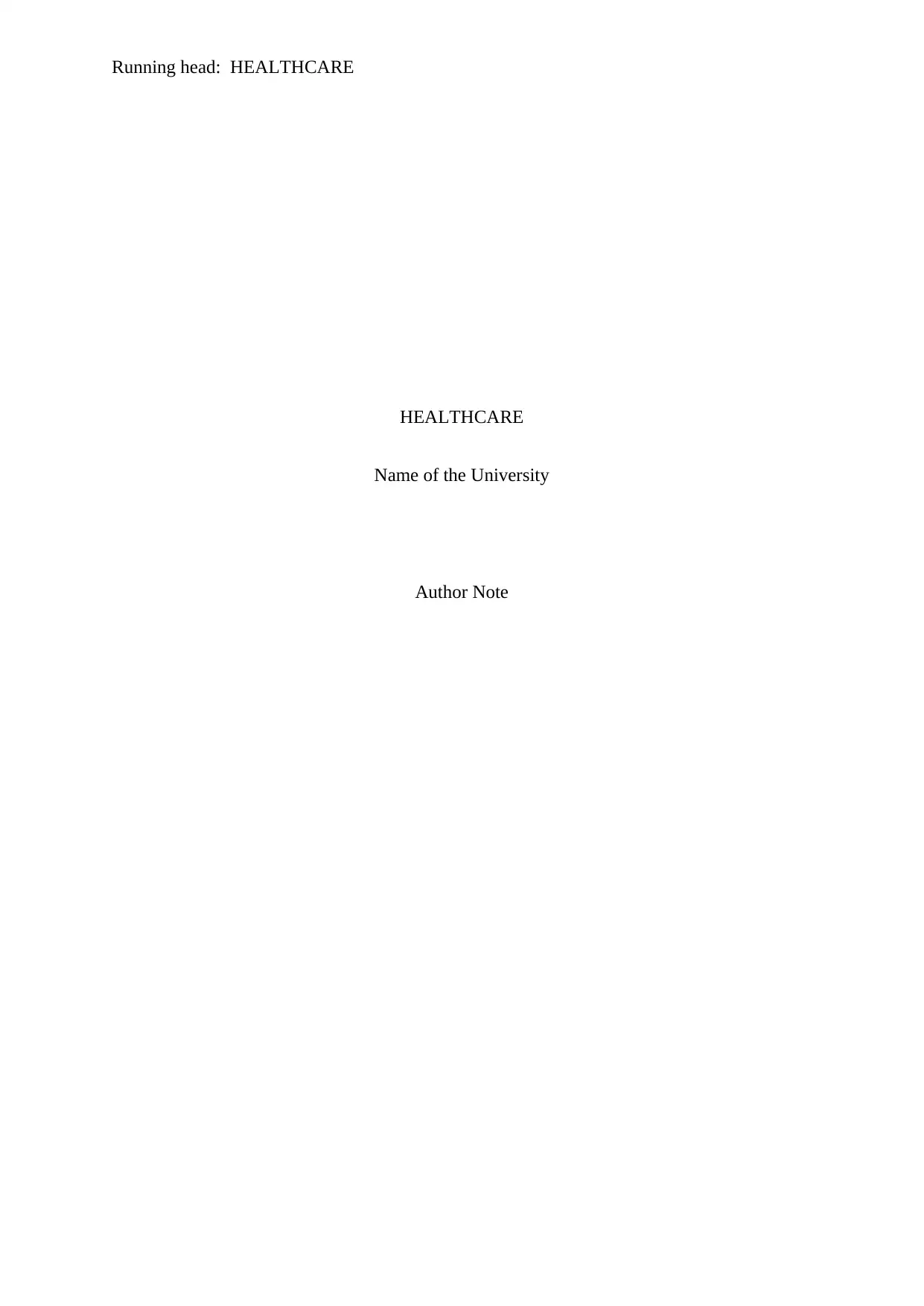
Running head: HEALTHCARE
HEALTHCARE
Name of the University
Author Note
HEALTHCARE
Name of the University
Author Note
Paraphrase This Document
Need a fresh take? Get an instant paraphrase of this document with our AI Paraphraser
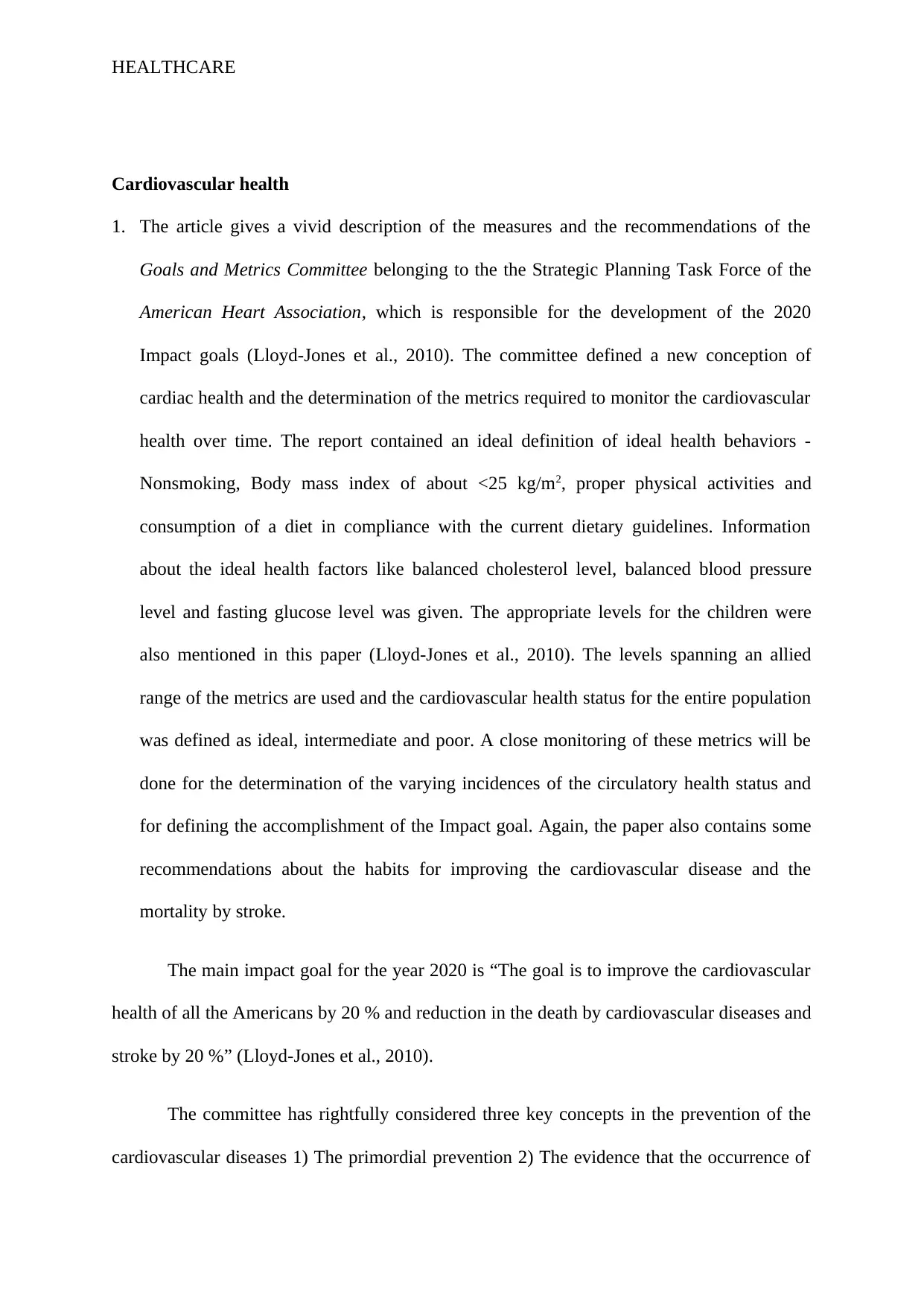
HEALTHCARE
Cardiovascular health
1. The article gives a vivid description of the measures and the recommendations of the
Goals and Metrics Committee belonging to the the Strategic Planning Task Force of the
American Heart Association, which is responsible for the development of the 2020
Impact goals (Lloyd-Jones et al., 2010). The committee defined a new conception of
cardiac health and the determination of the metrics required to monitor the cardiovascular
health over time. The report contained an ideal definition of ideal health behaviors -
Nonsmoking, Body mass index of about <25 kg/m2, proper physical activities and
consumption of a diet in compliance with the current dietary guidelines. Information
about the ideal health factors like balanced cholesterol level, balanced blood pressure
level and fasting glucose level was given. The appropriate levels for the children were
also mentioned in this paper (Lloyd-Jones et al., 2010). The levels spanning an allied
range of the metrics are used and the cardiovascular health status for the entire population
was defined as ideal, intermediate and poor. A close monitoring of these metrics will be
done for the determination of the varying incidences of the circulatory health status and
for defining the accomplishment of the Impact goal. Again, the paper also contains some
recommendations about the habits for improving the cardiovascular disease and the
mortality by stroke.
The main impact goal for the year 2020 is “The goal is to improve the cardiovascular
health of all the Americans by 20 % and reduction in the death by cardiovascular diseases and
stroke by 20 %” (Lloyd-Jones et al., 2010).
The committee has rightfully considered three key concepts in the prevention of the
cardiovascular diseases 1) The primordial prevention 2) The evidence that the occurrence of
Cardiovascular health
1. The article gives a vivid description of the measures and the recommendations of the
Goals and Metrics Committee belonging to the the Strategic Planning Task Force of the
American Heart Association, which is responsible for the development of the 2020
Impact goals (Lloyd-Jones et al., 2010). The committee defined a new conception of
cardiac health and the determination of the metrics required to monitor the cardiovascular
health over time. The report contained an ideal definition of ideal health behaviors -
Nonsmoking, Body mass index of about <25 kg/m2, proper physical activities and
consumption of a diet in compliance with the current dietary guidelines. Information
about the ideal health factors like balanced cholesterol level, balanced blood pressure
level and fasting glucose level was given. The appropriate levels for the children were
also mentioned in this paper (Lloyd-Jones et al., 2010). The levels spanning an allied
range of the metrics are used and the cardiovascular health status for the entire population
was defined as ideal, intermediate and poor. A close monitoring of these metrics will be
done for the determination of the varying incidences of the circulatory health status and
for defining the accomplishment of the Impact goal. Again, the paper also contains some
recommendations about the habits for improving the cardiovascular disease and the
mortality by stroke.
The main impact goal for the year 2020 is “The goal is to improve the cardiovascular
health of all the Americans by 20 % and reduction in the death by cardiovascular diseases and
stroke by 20 %” (Lloyd-Jones et al., 2010).
The committee has rightfully considered three key concepts in the prevention of the
cardiovascular diseases 1) The primordial prevention 2) The evidence that the occurrence of
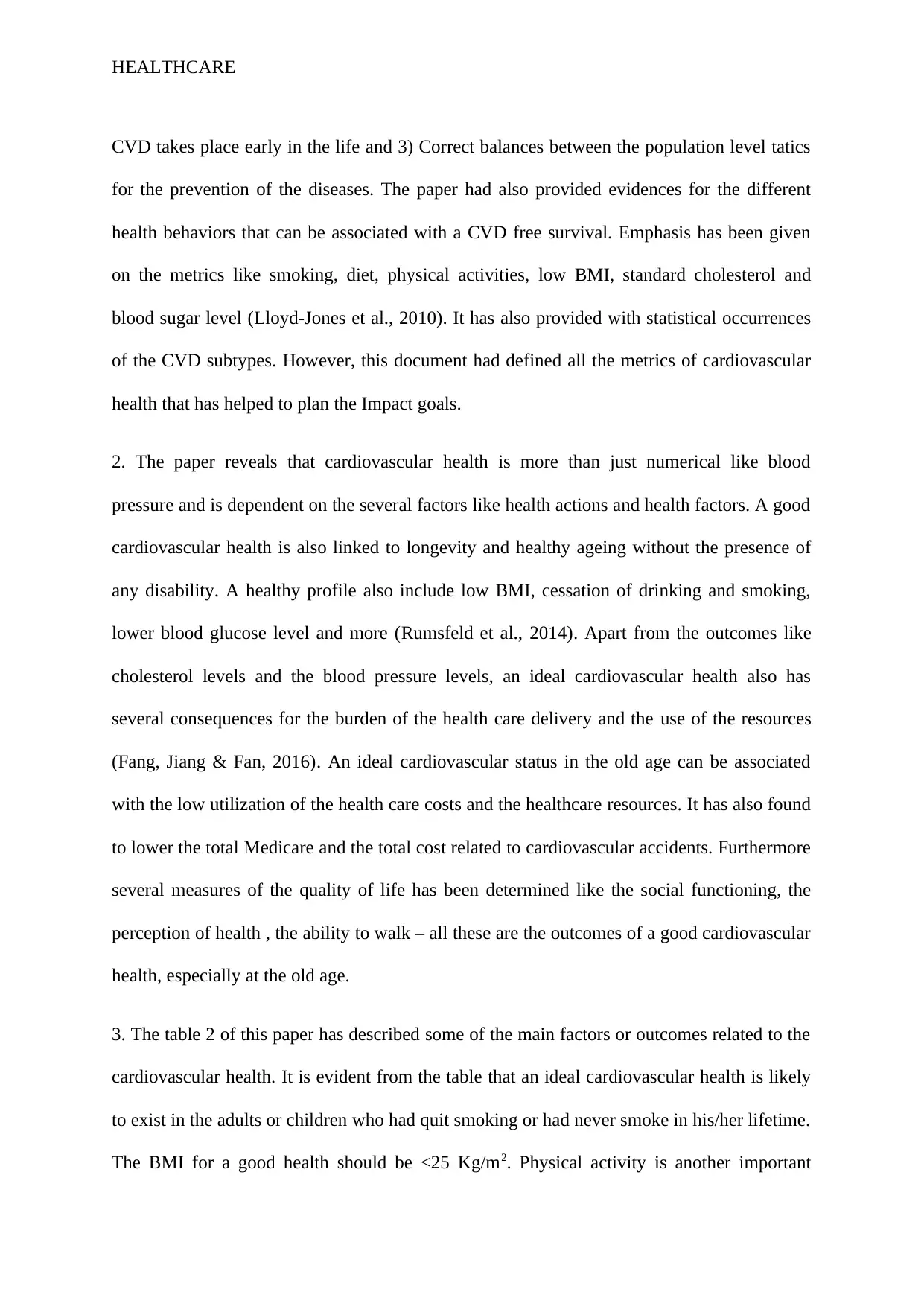
HEALTHCARE
CVD takes place early in the life and 3) Correct balances between the population level tatics
for the prevention of the diseases. The paper had also provided evidences for the different
health behaviors that can be associated with a CVD free survival. Emphasis has been given
on the metrics like smoking, diet, physical activities, low BMI, standard cholesterol and
blood sugar level (Lloyd-Jones et al., 2010). It has also provided with statistical occurrences
of the CVD subtypes. However, this document had defined all the metrics of cardiovascular
health that has helped to plan the Impact goals.
2. The paper reveals that cardiovascular health is more than just numerical like blood
pressure and is dependent on the several factors like health actions and health factors. A good
cardiovascular health is also linked to longevity and healthy ageing without the presence of
any disability. A healthy profile also include low BMI, cessation of drinking and smoking,
lower blood glucose level and more (Rumsfeld et al., 2014). Apart from the outcomes like
cholesterol levels and the blood pressure levels, an ideal cardiovascular health also has
several consequences for the burden of the health care delivery and the use of the resources
(Fang, Jiang & Fan, 2016). An ideal cardiovascular status in the old age can be associated
with the low utilization of the health care costs and the healthcare resources. It has also found
to lower the total Medicare and the total cost related to cardiovascular accidents. Furthermore
several measures of the quality of life has been determined like the social functioning, the
perception of health , the ability to walk – all these are the outcomes of a good cardiovascular
health, especially at the old age.
3. The table 2 of this paper has described some of the main factors or outcomes related to the
cardiovascular health. It is evident from the table that an ideal cardiovascular health is likely
to exist in the adults or children who had quit smoking or had never smoke in his/her lifetime.
The BMI for a good health should be <25 Kg/m2. Physical activity is another important
CVD takes place early in the life and 3) Correct balances between the population level tatics
for the prevention of the diseases. The paper had also provided evidences for the different
health behaviors that can be associated with a CVD free survival. Emphasis has been given
on the metrics like smoking, diet, physical activities, low BMI, standard cholesterol and
blood sugar level (Lloyd-Jones et al., 2010). It has also provided with statistical occurrences
of the CVD subtypes. However, this document had defined all the metrics of cardiovascular
health that has helped to plan the Impact goals.
2. The paper reveals that cardiovascular health is more than just numerical like blood
pressure and is dependent on the several factors like health actions and health factors. A good
cardiovascular health is also linked to longevity and healthy ageing without the presence of
any disability. A healthy profile also include low BMI, cessation of drinking and smoking,
lower blood glucose level and more (Rumsfeld et al., 2014). Apart from the outcomes like
cholesterol levels and the blood pressure levels, an ideal cardiovascular health also has
several consequences for the burden of the health care delivery and the use of the resources
(Fang, Jiang & Fan, 2016). An ideal cardiovascular status in the old age can be associated
with the low utilization of the health care costs and the healthcare resources. It has also found
to lower the total Medicare and the total cost related to cardiovascular accidents. Furthermore
several measures of the quality of life has been determined like the social functioning, the
perception of health , the ability to walk – all these are the outcomes of a good cardiovascular
health, especially at the old age.
3. The table 2 of this paper has described some of the main factors or outcomes related to the
cardiovascular health. It is evident from the table that an ideal cardiovascular health is likely
to exist in the adults or children who had quit smoking or had never smoke in his/her lifetime.
The BMI for a good health should be <25 Kg/m2. Physical activity is another important
⊘ This is a preview!⊘
Do you want full access?
Subscribe today to unlock all pages.

Trusted by 1+ million students worldwide
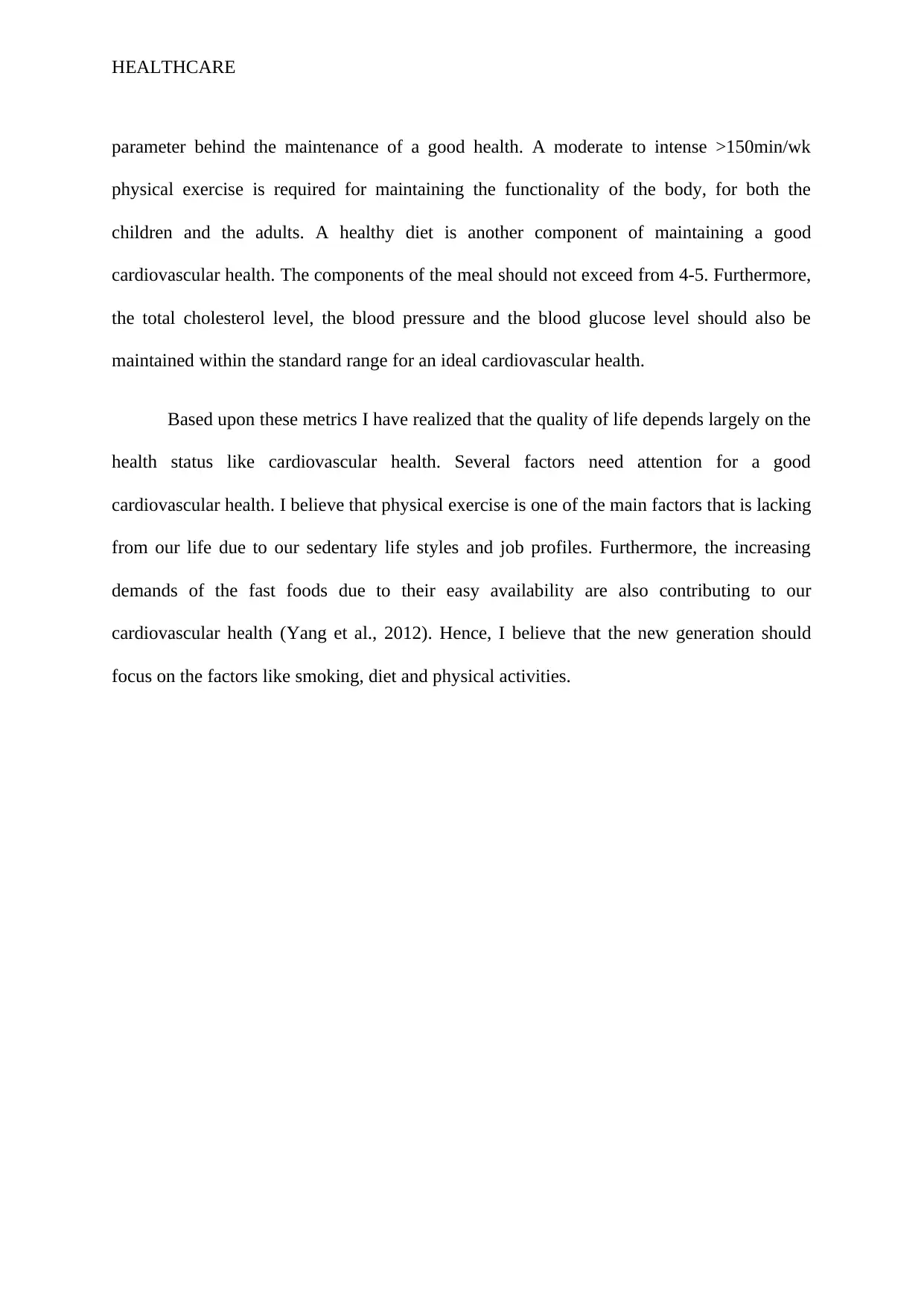
HEALTHCARE
parameter behind the maintenance of a good health. A moderate to intense >150min/wk
physical exercise is required for maintaining the functionality of the body, for both the
children and the adults. A healthy diet is another component of maintaining a good
cardiovascular health. The components of the meal should not exceed from 4-5. Furthermore,
the total cholesterol level, the blood pressure and the blood glucose level should also be
maintained within the standard range for an ideal cardiovascular health.
Based upon these metrics I have realized that the quality of life depends largely on the
health status like cardiovascular health. Several factors need attention for a good
cardiovascular health. I believe that physical exercise is one of the main factors that is lacking
from our life due to our sedentary life styles and job profiles. Furthermore, the increasing
demands of the fast foods due to their easy availability are also contributing to our
cardiovascular health (Yang et al., 2012). Hence, I believe that the new generation should
focus on the factors like smoking, diet and physical activities.
parameter behind the maintenance of a good health. A moderate to intense >150min/wk
physical exercise is required for maintaining the functionality of the body, for both the
children and the adults. A healthy diet is another component of maintaining a good
cardiovascular health. The components of the meal should not exceed from 4-5. Furthermore,
the total cholesterol level, the blood pressure and the blood glucose level should also be
maintained within the standard range for an ideal cardiovascular health.
Based upon these metrics I have realized that the quality of life depends largely on the
health status like cardiovascular health. Several factors need attention for a good
cardiovascular health. I believe that physical exercise is one of the main factors that is lacking
from our life due to our sedentary life styles and job profiles. Furthermore, the increasing
demands of the fast foods due to their easy availability are also contributing to our
cardiovascular health (Yang et al., 2012). Hence, I believe that the new generation should
focus on the factors like smoking, diet and physical activities.
Paraphrase This Document
Need a fresh take? Get an instant paraphrase of this document with our AI Paraphraser
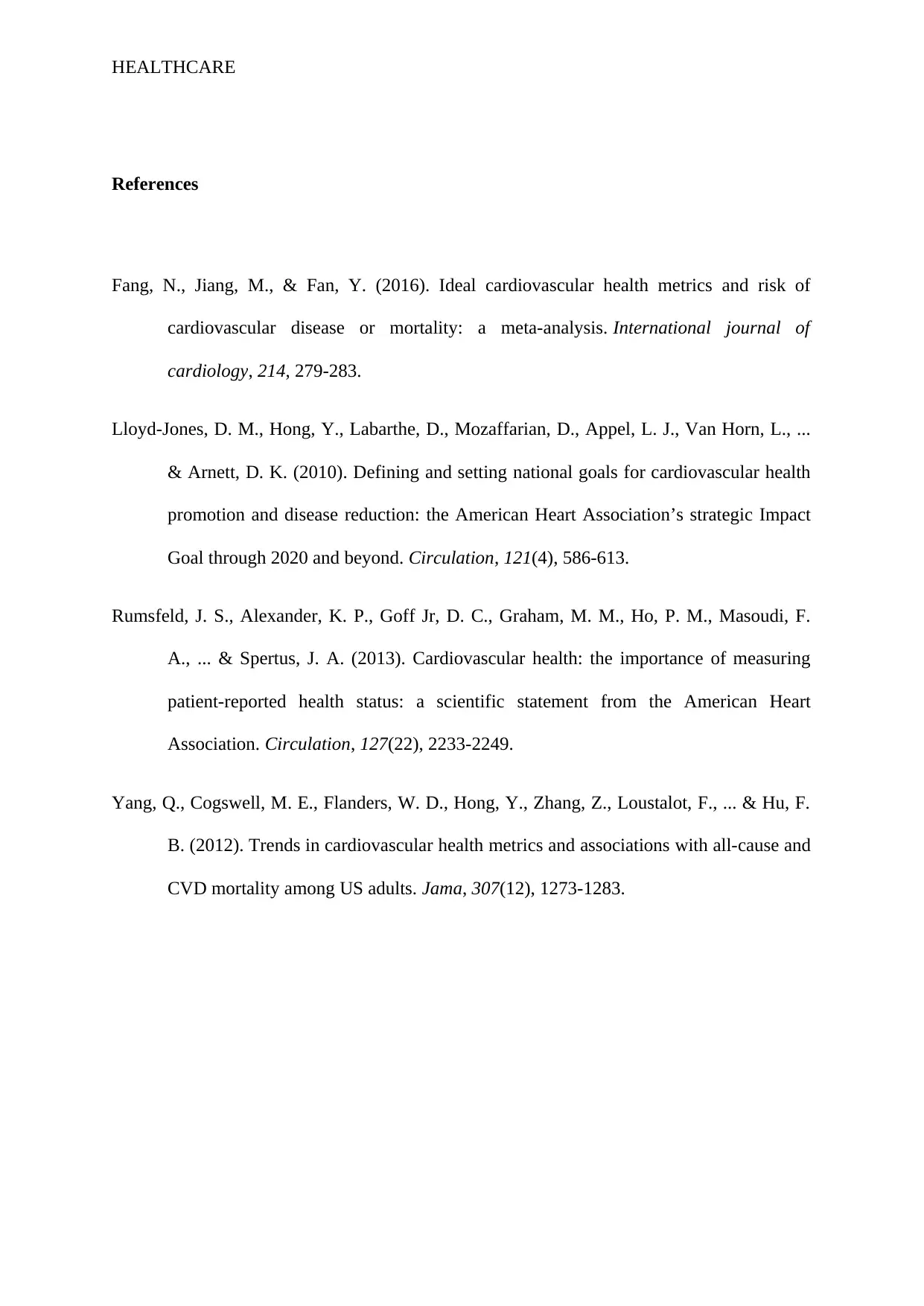
HEALTHCARE
References
Fang, N., Jiang, M., & Fan, Y. (2016). Ideal cardiovascular health metrics and risk of
cardiovascular disease or mortality: a meta-analysis. International journal of
cardiology, 214, 279-283.
Lloyd-Jones, D. M., Hong, Y., Labarthe, D., Mozaffarian, D., Appel, L. J., Van Horn, L., ...
& Arnett, D. K. (2010). Defining and setting national goals for cardiovascular health
promotion and disease reduction: the American Heart Association’s strategic Impact
Goal through 2020 and beyond. Circulation, 121(4), 586-613.
Rumsfeld, J. S., Alexander, K. P., Goff Jr, D. C., Graham, M. M., Ho, P. M., Masoudi, F.
A., ... & Spertus, J. A. (2013). Cardiovascular health: the importance of measuring
patient-reported health status: a scientific statement from the American Heart
Association. Circulation, 127(22), 2233-2249.
Yang, Q., Cogswell, M. E., Flanders, W. D., Hong, Y., Zhang, Z., Loustalot, F., ... & Hu, F.
B. (2012). Trends in cardiovascular health metrics and associations with all-cause and
CVD mortality among US adults. Jama, 307(12), 1273-1283.
References
Fang, N., Jiang, M., & Fan, Y. (2016). Ideal cardiovascular health metrics and risk of
cardiovascular disease or mortality: a meta-analysis. International journal of
cardiology, 214, 279-283.
Lloyd-Jones, D. M., Hong, Y., Labarthe, D., Mozaffarian, D., Appel, L. J., Van Horn, L., ...
& Arnett, D. K. (2010). Defining and setting national goals for cardiovascular health
promotion and disease reduction: the American Heart Association’s strategic Impact
Goal through 2020 and beyond. Circulation, 121(4), 586-613.
Rumsfeld, J. S., Alexander, K. P., Goff Jr, D. C., Graham, M. M., Ho, P. M., Masoudi, F.
A., ... & Spertus, J. A. (2013). Cardiovascular health: the importance of measuring
patient-reported health status: a scientific statement from the American Heart
Association. Circulation, 127(22), 2233-2249.
Yang, Q., Cogswell, M. E., Flanders, W. D., Hong, Y., Zhang, Z., Loustalot, F., ... & Hu, F.
B. (2012). Trends in cardiovascular health metrics and associations with all-cause and
CVD mortality among US adults. Jama, 307(12), 1273-1283.
1 out of 5
Related Documents
Your All-in-One AI-Powered Toolkit for Academic Success.
+13062052269
info@desklib.com
Available 24*7 on WhatsApp / Email
![[object Object]](/_next/static/media/star-bottom.7253800d.svg)
Unlock your academic potential
Copyright © 2020–2025 A2Z Services. All Rights Reserved. Developed and managed by ZUCOL.





